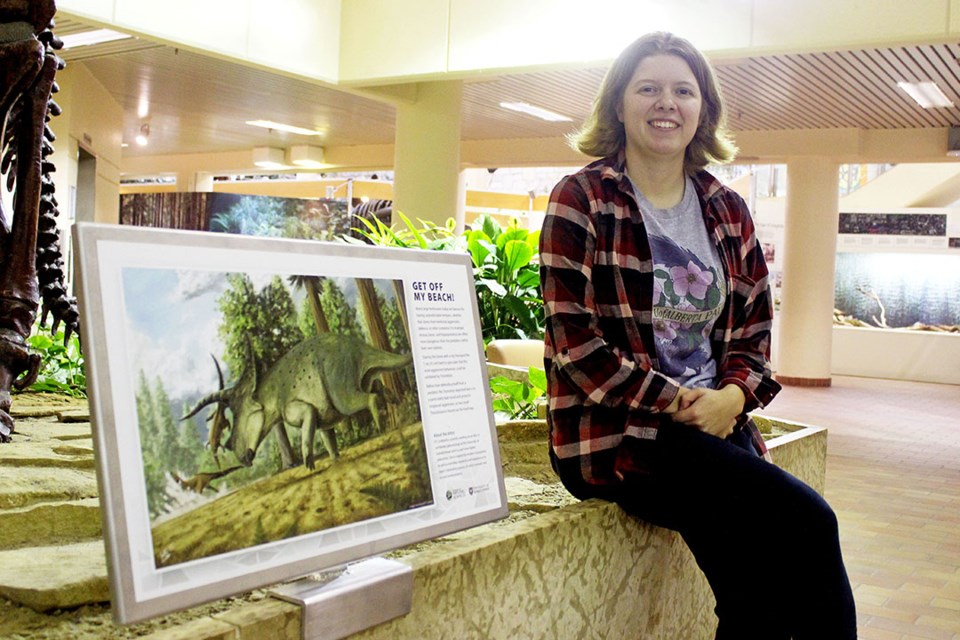SASKATOON — USask geological sciences graduate student Kaitlin “KT” Lindblad reimagines some of the world’s best-known dinosaurs with artwork.
In the media, Tyrannosaurus rex is known as one of the most ruthless and terrifying creatures to have ever roamed the Earth.
A University of Saskatchewan (USask) graduate student is using her artwork to challenge that perception and show the extinct species as it was—an animal, going about its life, taking care of its young and its own basic needs.
Artwork by USask geological sciences master’s student Kaitlin “KT” Lindblad sits in front of two of the most recognizable fossil replicas in the Museum of Natural Sciences on campus—Tyrannosaurus rex and Triceratops.
“The theme with these pieces … is depicting extinct animals in less traditional ways than they’re usually portrayed,” Lindblad said. “If you see any artwork, or Google artwork of a T. rex, it’s going to be shown as a scary Kaiju-Godzilla-type (creature).”
“Jurassic Park has heavily played into how these things are imagined,” she added.
The artwork, or “paleoart,” in front of the T. rex at the museum depicts the usually fearsome creature scratching an itch that it couldn’t reach on a tree.
“T. rex has kind of a very goofy face because they have binocular vision,” she added. “They specifically have that weirdly boxy skull, so their eyes point forward. The front facing view of T. rex, they look kind of silly.”
Paleoart is the use of artwork in paleontology to show prehistoric life informed by scientific evidence. Lindblad uses scientific knowledge about animal species today to interpret how extinct animals, like T. rex, may have behaved and depict those characteristics in her artwork.
“We don’t really think of the T. rex as a good parent, right?” Lindblad said. “The only living dinosaurs in our world are birds. We know (birds) are pretty good parents—not all, but a good chunk of birds are good parents.”
On the other side of the main entrance of the Geology Building, Lindblad’s artwork shows the Triceratops—usually depicted as a docile and passive herbivore—acting aggressively towards other dinosaurs. Her inspiration for showing Triceratops in a more aggressive scene comes from real-life hippopotamuses and zebras in Africa.
“Cape Buffalos, zebras, hippos—the deadliest animals in those places are not the lions or the cheetahs. The Cape Buffalo and hippos are responsible for most attacks,” Lindblad said. “These animals have very famously bad tempers, probably because they need to defend themselves from things like lions.”
Even the way the fossil replicas are posed reinforces the idea of a “Kaiju-type” creature, Lindblad said. T. rex wouldn’t have had a “kangaroo” stance and Godzilla-like “stomping around.” This commonly depicted power stance of T. rex was influenced by the opinions of scientists at the time.
Lindblad’s foray into paleoart started during her undergraduate degree at the University of Regina. For her undergraduate thesis, she decided to draw an extinct crocodilian found from the Big Muddy Badlands. A friend took note and recommended Lindblad for commissioned projects.
“I have done traditional work, but I wasn’t going for a super, hyper realistic method, showing every single scale,” she said. “I like getting the overall feel for that, like a more painter-y style. That’s the stuff I’m gravitated toward. It’s also a fun exercise in playing with colour and light without being bogged down too much.”
As she started her master’s degree at USask, Geological Sciences professors Drs. Luis Buatois (PhD), Gabriela Mángano (PhD) and adjunct professor Emily Bamforth (PhD) learned about her paleoart. USask faculty members and friends have helped encourage her interest and connected her with USask Museum of Natural Sciences manager Erica Bird.
Bird was looking for a way to share knowledge in a way that wasn’t a one directional approach–from experts to visitors.
“I feel like museums are a place to open up conversations about things, and in particular, I was keen on the idea of how we, humans, are doing science. We have bias,” Bird said.
When she learned about Lindblad’s paleoart from faculty in the Department of Geological Sciences, she commissioned the two pieces last year.
“The question we’re asking is about the way we’re observing the world,” she added. “How Jurassic Park has affected how we see (dinosaurs). They’ve captured our imagination and we’ve been told stories about them and increased things a bit with extra drama that may not be scientifically accurate. And then future scientists are biased by some of that media. I wanted this to be a place where visitors could question it a little bit and give it some thought.”
While it can be challenging to imagine what dinosaurs looked like based on their skeletal remains, Lindblad has had the opportunity to travel to conferences to meet other well-known paleontologists and paleoartists in the industry.
Lindblad will be defending her thesis in spring on extinct crocodilians, her main research focus. When sketching the Triceratops image, she also included the alligator-relative Brachychampsa that lived alongside these dinosaurs, in the background near the tree line.
“Now and then, (paleontologists) come across the exceedingly rare fossil that preserves the skin or feathers, or some sort of behaviour or weird feature that we would have no idea about otherwise,” Lindblad said. “We’re getting a tiny bit closer to reality every day and that’s also a good reminder of the importance and fun of reimagining extinct animals in new and interesting ways.”
Lindblad noted that paleoart is about science and imagination working together “in an attempt to showcase what we do know, what we don’t, what we are missing, what we may never know, and where our biases lie. “Art is the only way to know these (prehistoric) animals,” she said.
— submitted by USask Media Relations




